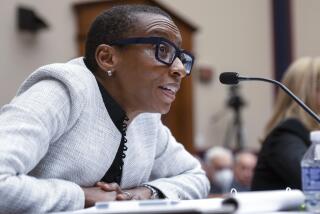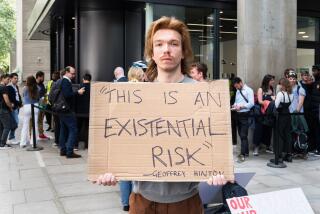Da Vinci code of justice
- Share via
NO ONE OWNS THE FACTS OF HISTORY. Two British historians, however, are claiming title to a juicy historical myth at the core of the bestseller “The Da Vinci Code,” and their claim should trouble anyone whose book or film was inspired by someone else’s theories.
The dispute pits Richard Leigh and Michael Baigent, two-thirds of the writing team behind “Holy Blood, Holy Grail,” against Dan Brown and his similarly themed 2003 novel. Leigh and Baigent complain that Brown stole the “architecture” of “The Da Vinci Code” from their extensively researched nonfiction tome, first published in 1982.
Brown was dragged into a court in London on Monday to testify; the case is expected to wrap up by next week. If it were a run-of-the-mill copyright claim, Leigh and Baigent would argue that Brown lifted passages of their work verbatim, or that his work as a whole was substantially similar to theirs. Instead, they maintain that Brown built his novel around the central assertion of their book (warning: spoilers ahead) -- that a secretive French religious society covered up evidence of a lineage descended from the offspring of Jesus Christ and Mary Magdalene. Leigh and Baigent present this as theory, while Brown’s characters treat it as startling fact.
There certainly are similarities between passages of the two books. On his website, Carl Olson, coauthor of a book debunking the theories popularized by “The Da Vinci Code,” cites more than a dozen instances in which Brown’s words resemble or summarize parts of “Holy Blood, Holy Grail.”
It might seem unfair for Brown to make a fortune from ideas generated by others’ research. (He does give a nod to “Holy Blood, Holy Grail” in his book but says he didn’t read it until after he’d written most of “The Da Vinci Code.”) But writers have practiced such borrowing for centuries. Held to this standard, William Shakespeare, who took the plots for most of his plays from popular histories or even other fiction writers, would be condemned as a plagiarist.
There’s more at stake here than Brown’s royalties. If the judge in London rules that the set of ideas Leigh and Baigent espoused can be copyrighted, it would set a troubling precedent that could trip up authors and filmmakers who craft works around any new historic or scientific research. It’s worth noting that a federal judge in New York rejected a lawsuit against Brown last year by novelist Lewis Perdue, saying any similarity between their books was in ideas that could not be copyrighted.
Copyright law is already too far-reaching, particularly in the U.S., where many works are automatically protected for 70 years past the author’s death. Perhaps the most important limit on that protection is that it does not apply to facts, ideas or theories, just expressions of them. Although the line between ideas and expressions can be blurry, it should be clear enough to let novelists and filmmakers build their fiction on a foundation of history -- real or theoretical.
More to Read
Sign up for our Book Club newsletter
Get the latest news, events and more from the Los Angeles Times Book Club, and help us get L.A. reading and talking.
You may occasionally receive promotional content from the Los Angeles Times.








